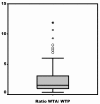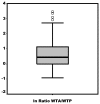Differences between willingness to pay and willingness to accept for visits by a family physician: a contingent valuation study
- PMID: 20459714
- PMCID: PMC2883536
- DOI: 10.1186/1471-2458-10-236
Differences between willingness to pay and willingness to accept for visits by a family physician: a contingent valuation study
Abstract
Background: The economic value attributed by users of health services in public health systems can be useful in planning and evaluation. This value can differ from the perspectives of Willingness to Pay (WTP) and Willingness to Accept [Compensation] (WTA).Our objective was to study the perceptions of the patient about the service provided by the family physician by means of the WTA/WTP ratio.
Methods: An economic evaluation study by the Contingent Valuation Method was designed. Interviews were conducted with 451 subjects at six health centres (four urban and two rural) in areas with different socioeconomic characteristics. A payment card was used to measure the WTP and WTA. Other characteristics of the subject or service that could influence these responses were collected. An explicative model was constructed to study the WTA/WTP relationship.
Results: Four hundred and four subjects (89.6%) expressed a WTP and WTA different from zero. The WTA/WTP quotient showed a median of 1.55 (interquartile range 1-3.08) and a mean of 3.30 (IC 95%: 2.84-3.75). The WTA/WTP ratio increases with age and in low-income areas. It decreases in professional groups with more specialized activities, with growing family income, and in the chronically ill. Other characteristics related to the perception of state of health, accessibility to the service, satisfaction, or perception of risk were not explicative.
Conclusions: Subjects who were older and had a less favourable socioeconomic situation expressed a higher WTA/WTP ratio when valuing the visit to the family physician. These characteristics could identify a profile of "aversion to loss" with respect to this service.
Figures
Similar articles
-
Valuing Healthcare Goods and Services: A Systematic Review and Meta-Analysis on the WTA-WTP Disparity.Pharmacoeconomics. 2020 May;38(5):443-458. doi: 10.1007/s40273-020-00890-x. Pharmacoeconomics. 2020. PMID: 32096146
-
A study of the user's perception of economic value in nursing visits to primary care by the method of contingent valuation.BMC Fam Pract. 2011 Oct 3;12:109. doi: 10.1186/1471-2296-12-109. BMC Fam Pract. 2011. PMID: 21967306 Free PMC article.
-
How do patients prefer specialized clinical pharmacy service to other prevention of mother-to-child transmission of human immunodeficiency virus services? An evaluation of their willingness to pay and willingness to accept choices and ratios.J Clin Pharm Ther. 2021 Dec;46(6):1695-1705. doi: 10.1111/jcpt.13519. Epub 2021 Aug 27. J Clin Pharm Ther. 2021. PMID: 34448210
-
"Gaining or losing": The importance of the perspective in primary care health services valuation.PLoS One. 2017 Dec 5;12(12):e0188969. doi: 10.1371/journal.pone.0188969. eCollection 2017. PLoS One. 2017. PMID: 29206847 Free PMC article.
-
The criterion validity of willingness to pay methods: A systematic review and meta-analysis of the evidence.Soc Sci Med. 2019 Jul;232:238-261. doi: 10.1016/j.socscimed.2019.04.015. Epub 2019 Apr 25. Soc Sci Med. 2019. PMID: 31108330
Cited by
-
Valuing Healthcare Goods and Services: A Systematic Review and Meta-Analysis on the WTA-WTP Disparity.Pharmacoeconomics. 2020 May;38(5):443-458. doi: 10.1007/s40273-020-00890-x. Pharmacoeconomics. 2020. PMID: 32096146
-
Mothers' willingness to accept and pay for vaccines to their children in western Iran: a contingent valuation study.BMC Pediatr. 2020 Jun 23;20(1):307. doi: 10.1186/s12887-020-02208-4. BMC Pediatr. 2020. PMID: 32576156 Free PMC article.
-
Patient preferences and cost-benefit of hypertension and hyperlipidemia collaborative management model between pharmacies and primary care in Portugal: A discrete choice experiment alongside a trial (USFarmácia®).PLoS One. 2023 Oct 5;18(10):e0292308. doi: 10.1371/journal.pone.0292308. eCollection 2023. PLoS One. 2023. PMID: 37796918 Free PMC article. Clinical Trial.
-
A study of the user's perception of economic value in nursing visits to primary care by the method of contingent valuation.BMC Fam Pract. 2011 Oct 3;12:109. doi: 10.1186/1471-2296-12-109. BMC Fam Pract. 2011. PMID: 21967306 Free PMC article.
-
Preferences of Iranian medical students for selecting the compulsory service plan packages: A discrete choice experiment.Health Sci Rep. 2024 Jun 25;7(6):e2213. doi: 10.1002/hsr2.2213. eCollection 2024 Jun. Health Sci Rep. 2024. PMID: 38933426 Free PMC article.
References
-
- Sayman S, Onculer A. Effects of study design characteristics on the WTA-WTP disparity: A meta analytical framework. Journal of Economic Psychology. 2005;26:289–312. doi: 10.1016/j.joep.2004.07.002. - DOI
Publication types
MeSH terms
LinkOut - more resources
Full Text Sources



